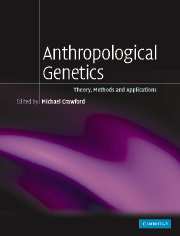Book contents
- Frontmatter
- Contents
- List of Contributors
- Preface
- Chapter 1 Foundations of Anthropological Genetics
- Part 1 Theory
- Part 2 Methods
- Part 3 General Applications
- Chapter 9 Applications of Molecular Genetics to Forensic Sciences
- Chapter 10 Emerging Technologies: The Bright Future of Fluorescence
- Chapter 11 Mapping Genes Influencing Human Quantitative Trait Variation
- Part 4 Part IV The Human Diaspora
- Index
- References
Chapter 10 - Emerging Technologies: The Bright Future of Fluorescence
Published online by Cambridge University Press: 05 June 2012
- Frontmatter
- Contents
- List of Contributors
- Preface
- Chapter 1 Foundations of Anthropological Genetics
- Part 1 Theory
- Part 2 Methods
- Part 3 General Applications
- Chapter 9 Applications of Molecular Genetics to Forensic Sciences
- Chapter 10 Emerging Technologies: The Bright Future of Fluorescence
- Chapter 11 Mapping Genes Influencing Human Quantitative Trait Variation
- Part 4 Part IV The Human Diaspora
- Index
- References
Summary
Introduction
Oligonucleotide-driven, polymerase-catalyzed in vitro molecular reactions, specifically the polymerase chain reaction (PCR) and chain-termination DNA sequencing, have revolutionized our access to and understanding of genetics. Born less than three decades ago, these two techniques have together led to the phenomena of whole-genome sequencing, mass gene expression analyses, high-throughput drug discovery, and ‘disease-of-the-week’ mutation mapping – to name but a few. Major players in these advances range from the very small, like the bacterium Thermus aquaticus, that gave us thermal-stable DNA polymerase, to almost larger than life, like H. Gobind Khorana, under whose guidance the basic chemistries of oligonucleotide synthesis were developed. No less important is the smallest player of all, the fluorescent molecule. Appreciation for the potential of fluorescence as a tool in molecular biology pre-dates the advent of both chain-termination DNA sequencing and PCR, but it is only in the past few years that specific applications have begun to flower and pay huge dividends.
In this chapter I will present the basics of fluorescence relevant to molecular biology, including fluorescence resonance energy transfer (FRET). From there, the three applications in which fluorescence has made a significant contribution will be discussed. These are: chain-termination DNA sequencing, kinetic (real-time) PCR, and DNA microarrays. Finally, I will assess the role of fluorescence-aided molecular tools in Anthropological Genetics in the future as well as preview potential new fluorescence tools on the horizon.
- Type
- Chapter
- Information
- Anthropological GeneticsTheory, Methods and Applications, pp. 277 - 305Publisher: Cambridge University PressPrint publication year: 2006



